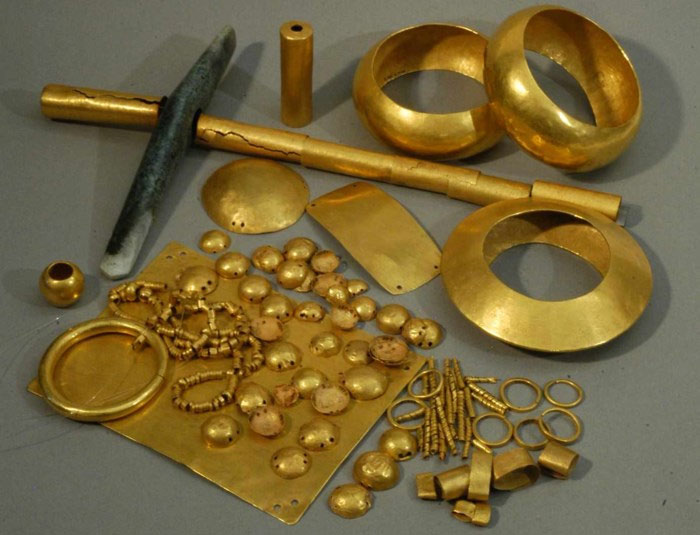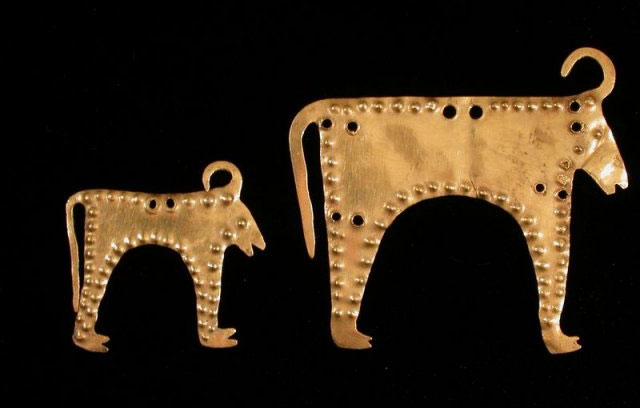Discover the secret from the gold store in Bulgaria
The treasure revealed in prehistoric tombs in Bulgaria is the first evidence of social stratification, but no one knows what causes the civilization to decline . What secrets does Varna's treasure contain?
Make house to reveal treasures

Some gold artifacts are found in the tomb of No. 43 in the cemetery of Varna.
The Varna Gold Warehouse seems quite strange when people find it. At the age of 25 (in 1972), Alexander Minchev earned his Ph.D. and accepted a job at the same museum he worked on until today: A Roman glass expert. One morning, Minchev received a call: A retired teacher opened a small museum in the neighboring village and kept some artifacts, perhaps from Varna and wanted to invite Mr. Michev to look over? At the end of the call, Minchev remembers that the local people were word of mouth about the so-called 'treasure'.
People love to pick up copper coins in their rice fields, some coins have been for several centuries. The galleries in the small museum are filled with coins. Eager to go see, Minchev and his colleague jumped onto the 'phi' car to the museum. Mr. Minchev recalled: 'When we entered the room and saw gold objects on the table, we suddenly exclaimed: It was extraordinary!'

This gold dish has been crafted from more than 6,000 years ago, having me like a cow but the horn is like buffalo.
The retired teacher said that a student had accidentally found strange artifacts while digging a hole in a power line a few weeks ago. Mr. Minchev recalls: 'In one hole, we found a lot of gold. It feels like the construction site is located on the ground of a graveyard, a temporary fence has been erected. '
When winter comes, the ground freezes, archaeologists burn fire to continue working. A local prison agreed to allow the prisoner to help archaeologists restore the gold in the graveyard. Bulgarian archaeologists who lost 15 years to excavate 312 tombs, these tombs date from 4600 BC to 4200 BC - a key point in human history when people learned The secret of alchemy.
Slavchev archaeologist said: 'The graveyard showed a big difference between the grave owners, some grave buried many goods, others were few. 6,500 years ago, people had the idea of burying valuable things for dead people like today. Here we see a first social complex '.
Ancient metal shaping society

Types of reliefs found in Varna cemetery.
Going through the gardens, Slavchev archaeologist said, those who built the Varna cemetery have a different mind: 'In general, they have good health and a balanced diet. They are not as rich or poor as the scene we see today. They don't feel too hungry. At one point, they thought more about survival . ' Mr. Slavchev thought that the Bronze people began to turn their attention to metal.
Five thousand years ago, farmers probably noticed that the green ore core that we know today is Stone Peacock or copper ore can melt to form copper particles. Copper can shape tools and jewelry in different ways. Before metallurgy, the instruments of mankind were often made from stone, wood, bone, gauze or clay. But when I break, I will give up; on the contrary, the copper is malleable and can be changed into a form of weapons, tools and jewelry.
Slavchev archaeologist affirmed: 'For the first time we mention the important point in human history when a part of society has to work with metal, and others create food to feed them. Someone has appointed for adjustment and decentralization, this individual makes decisions and requires power to keep society stable. '
The culprit is climate change?
Mr. Slavchev explained: 'During the next six centuries, this area seemed to be empty'. For decades, scholars have speculated that 'sudden abandonment' in Varna was the result of an invasion by the Indo-European warriors that archaeologist Gimbutas once wrote in his book. But there was no sign of war or violence, no burning village or any skeleton showing signs of being stabbed. A new hypothesis emerged.
The casual collapse of the Bronze Age was when the world warmed up, with a significant change in temperature and rainfall. The villages that used to cook gold are now submerged under water: the sea level of Hac Hai is 7.6 meters lower than today. From the roof of the cemetery may also be the highest point when below, the lake water has flooded the village. Gold could not save the life of Varna, the fields turned into swamps. The Slavchev archaeologist concluded: 'Perhaps when the fields turn into marshes. And climate change, making local people forced to change their lifestyles. '
- Discovered 5,000-year-old gold dagger
- Discovered a huge gold store at the bottom of the Pacific Ocean
- Discover new gold form in the center of Earth
- Discover the whole fungus covered with gold
- Discovering the legendary gold mine worth USD 1.7 billion?
- Gold skin care technology
- Visit the most secret places on the planet
- Million dollar gold store in wreck 200 years
- Australian man dug 4kg gold block
- Gold is formed like?
- The interesting thing about gold may be unknown to you
- Why do we like gold?
 Discovered an ancient centipede fossil 99 million years old
Discovered an ancient centipede fossil 99 million years old Discovered bat-like dinosaurs in China
Discovered bat-like dinosaurs in China Discovered a 200-year-old bronze cannon of the coast
Discovered a 200-year-old bronze cannon of the coast Discover 305 million-year-old spider fossils
Discover 305 million-year-old spider fossils